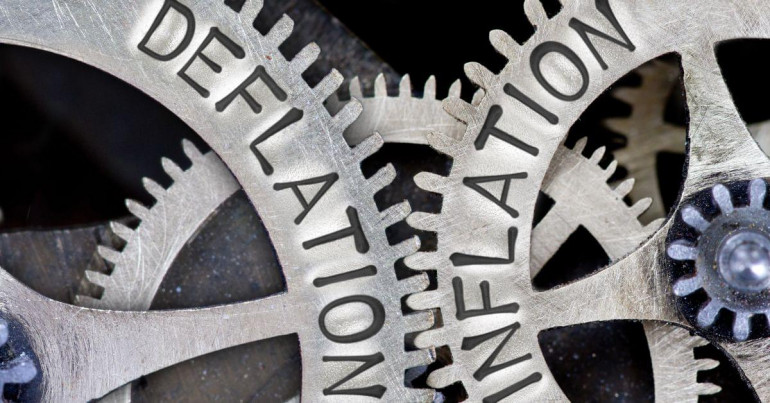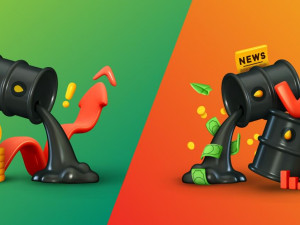
With inflation being the talk of the town, we wonder where the disinflationary and deflationary effects are hiding.
In this article, we look at what deflation is, the difference between deflation and disinflation, and how monetarists view the current period in terms of deflation compared to mainstream economists.

What is the difference between disinflation and deflation
The terms disinflation and deflation are often used interchangeably, but they refer to different macroeconomic phenomena.
Disinflation is the phenomenon we have been experiencing in recent months, where headline inflation is still high but has cooled off somewhat: prices are, therefore, still rising overall, but rising at a slower rate than before.
Deflation is the bogeyman of every economist and means an overall reduction in the level of prices or a negative inflation rate: it is what central banks briefly fought against in 2008 during the financial crisis with the then long-forgotten monetary stimulus known as ‘quantitative easing’.
It’s important to note that both disinflation and deflation can have varied consequences for an economy. Disinflation can lead to stagnation as businesses hold back investments due to uncertainty about future prices. On the other hand, deflation can be even more dangerous, as lower prices can lead companies to cut wages or jobs in order to remain profitable.
Monetary deflation vs. price deflation
Like inflation, deflation can also be defined in either monetary or price terms.
So-called ‘Monetarists’ have been on the fringes of economic theory in recent years. Still, their theories are gaining political currency, particularly at the liberal and libertarian end of the political spectrum.
According to monetarists, the meaning of the term ‘inflation’ changed during the twentieth century, with modern usage referring to an increase in consumer prices instead of an increase in the quantity of money. High inflation, or hyperinflation, is always the result of massive monetary inflation (“money printing”) in their thinking.
Monetarists, therefore, blame the current inflationary cycle on ‘money printing’ and fiscal stimulus during the covid crisis. However, since mid-2022, we have been in monetary deflation: central banks in Europe, the U.K. and the U.S. are shrinking their balance sheets, removing liquidity and currency from circulation, something we have not seen since money supply data has been published.
In monetary terms, we are currently actually experiencing deflation: the US money supply has contracted by 1.3% in December 2022 and experiencing the first decline ever measured in M2 data.
What does that mean for inflation? We don’t know. Monetarists would argue that the current contraction in the money supply is too little, too late and that we will have persistent inflation for a long time to come. Mainstream economists fear an imminent recession and would like to see central banks end the tightening cycle soon.

Which items have decreased in price?
If we only look at the consumer price index, which measures the cost of living for the ideal average citizen, we’re missing a key item that monetarists always look at in terms of inflation or deflation: asset prices. Here deflation is hiding in plain sight.
Also, energy has shown a disinflationary trend, and electronic items have even decreased in price.
Electronic items and household appliances
When it comes to consumer spending, one type of item stands out that has not experienced price pressure in recent years: electronic items. It seems that any increase in productivity and competitiveness in this sector is able to keep prices down.
In addition, the unpredictability of electronics prices due to supply chain issues over the past year may have contributed to the fall in prices. For example, the unadjusted price of smartphones fell by 23.9% over the year and the price of televisions fell by 13.2%. Similarly, major domestic appliances experienced an unadjusted percentage decline of 3.9% over the past 12 months, according to data collected in the United States.
While this sounds like a drop in the ocean, it may help encourage people to replace white goods with new, electricity-efficient ones and save on the energy bill going forward!
Energy
Despite all the headlines, energy prices have fallen significantly since September 2022. The price of natural gas on the wholesale markets has fallen dramatically.
We don’t hear much about this because the effect hasn’t yet reached the consumer.
In the UK and most European countries, household energy prices are set in advance based on a trailing average of past wholesale market prices. In the UK it is called the ‘energy price cap’.
The energy price cap has just been reviewed in February. Despite the underlying decline in wholesale energy prices, the price cap is still significantly higher than a year ago, with the typical household bill in the UK set to rise from £2,100 to £3,000 in April.
It is important to remember that the underlying gas prices have fallen by more than 80% from their peak. Due to the delayed effect of setting the energy price cap, these lower prices will not be reflected until the next energy price cap reset. Unless something changes dramatically and wholesale prices increase again towards autumn 2023, energy prices will stay in a disinflationary trend in 2023.
Investments and asset prices
The prices of various assets have fallen sharply over the past year, a phenomenon known as asset price deflation (the opposite of asset price inflation).
The effect of monetary policy and low or negative real interest rates has long been seen as a reason for the excessive rise in asset prices over the past 20-30 years.
This effect has now reversed as central banks have begun to tighten quantitatively. As a result, stock markets measured in the S&P 500 were down close to 20% in 2022. However, asset prices are not part of measuring consumer price inflation – they are considered outside of the scope of the ideal citizen defined by the consumer price index.
Inflation outlook
If you believe most economic forecasts, inflation is going to come down close to the target rate of 2 per cent in early 2024. A lot of contribution from shrinking energy prices and reduction in asset prices and the resulting lower wealth effect has already been achieved.
The question remains if wages will follow this way — or not. We have seen a record-setting low unemployment rate and a very strong labour market with wage bargaining power very strong. London bus drivers just managed to negotiate a pay rise of 18 per cent.
Such wage growth is well deserved for everyone, but it will be a headache for central bankers who seem to be willing to keep interest rates at high levels for longer until the target rate of inflation has been reached.
Subscribe to our newsletter here if you would like to receive our market updates straight to your inbox.
G.C. Wagner
Gustav Christopher is a writer specialising in finance, tech, and sustainability. Over 15 years, he worked in banking, trading and as a FinTech entrepreneur. In addition, he enjoys playing chess, running, and tennis.



